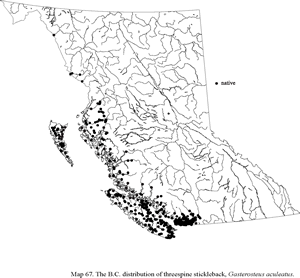Dorsal spines (total): 2 - 4; Dorsal soft rays (total): 10 - 14; Anal spines: 1; Anal soft rays: 8 - 10; Vertebrae: 29 - 33. Identified by the 3 to 4 sharp, free spines before the dorsal fin, the pelvic fin reduced to a sharp spine and a small ray, and the series of plates along the sides of the body. Gill rakers long and slender, 17 to 25 on the first arch or strictly freshwater forms, 1 or 2 more in anadromous forms; lateral line with microscopic pores. The anadromous form is fully plated, with up to 37 plates on the sides and a rather pronounced keel on each side of the caudal peduncle. Dorsal spines separated from each other and from the soft-rayed fins, each spine having a reduced membrane attached to its posterior side; anal spine free from rest of the fin; posterior margin of pectorals nearly truncate; caudal truncate to slightly indented. Freshwater forms usually mottled brown or greenish; anadromous forms silvery green to bluish black. A few isolated populations are black. Sides usually pale; belly yellow, white or silvery. Fins pale; pectoral rays often have dark dots. Breeding males (except for black forms) become brilliant bluish or green with blue or green eyes, and the forward part of the body, especially the breast region, turns bright red or orange. Caudal fin with 12 rays.
Source: FishBase. Banister, K. 1986 Gasterosteidae. p. 640-643. In P.J.P. Whitehead, M.-L. Bauchot, J.-C. Hureau, J. Nielsen and E. Tortonese (eds.) Fishes of the north-eastern Atlantic and the Mediterranean. volume 2. UNESCO, Paris.
